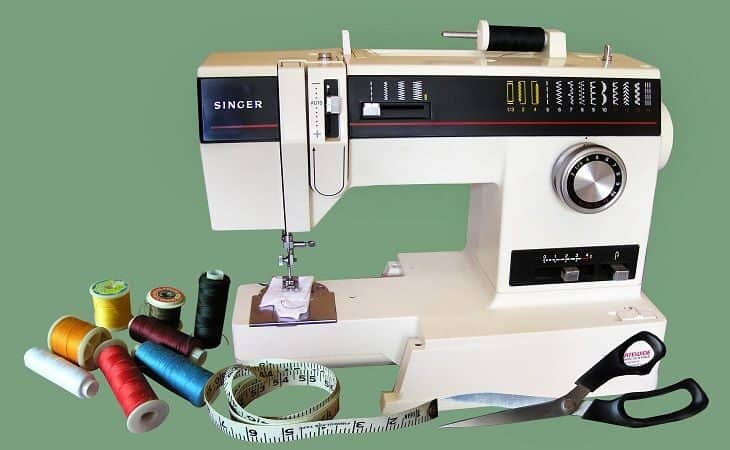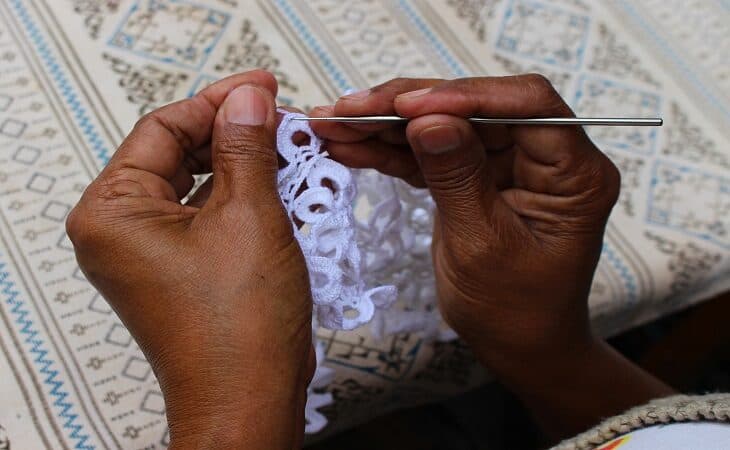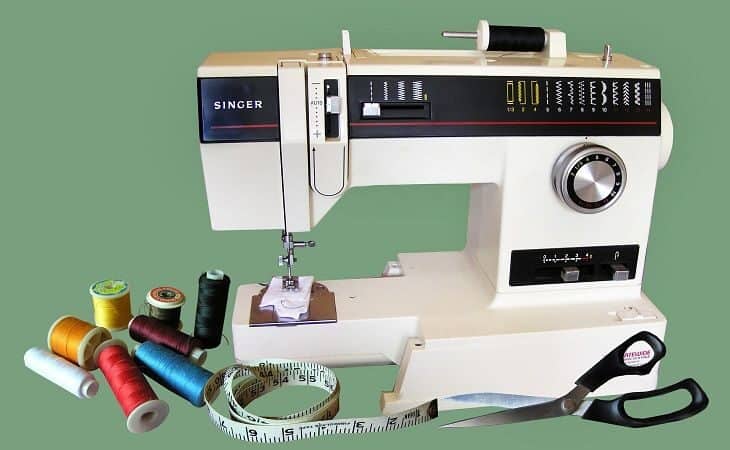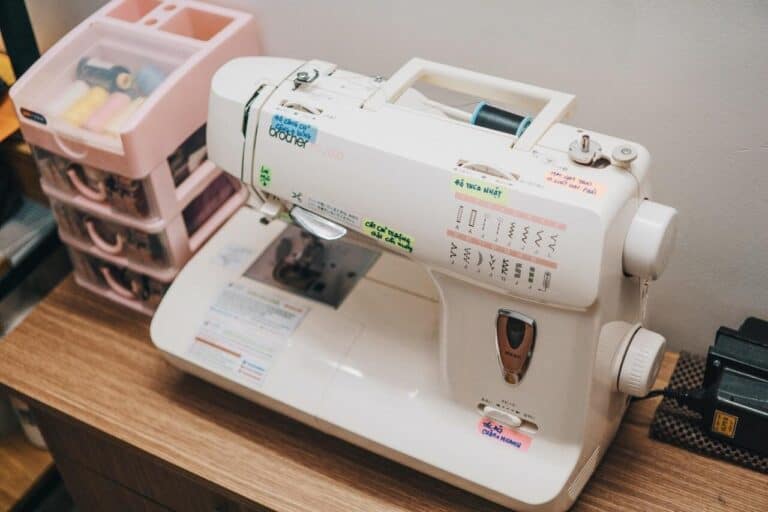Serger Vs Overlock Sewing Machines Reviews
This post may contain affiliate links which could provide us a small commission for our work at no cost to you.
Read the full disclosure here.
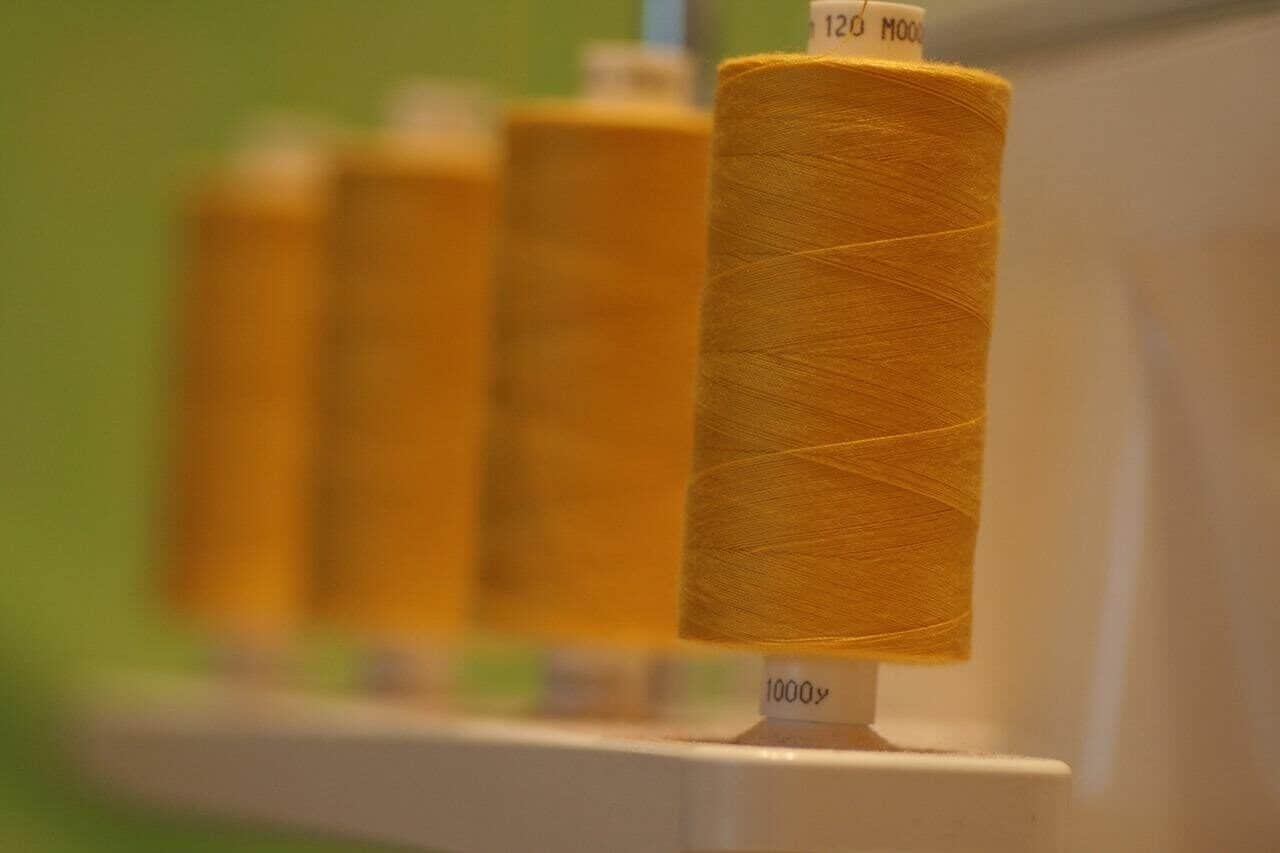
The sewing machine, at its most basic level, does a straight stitch on one thread that runs along the top of the fabric. This stich holds two pieces of fabric together. Most modern sewing machines also have several types of zigzag stitches available that are better for knit fabrics. The standard sewing machine will be able to sew just about anything for a sewing enthusiast, but there are caveats. They won’t handle different types of fabrics or give the professionally finished look of clothing you buy in the store. This is where specialty sewing machines come into play and where you might be interested in the serger vs overlock debate.

These machines make the life of a seamstress far easier and play an important role in creating that professional ready-to-wear feel of a garment. But in the world of specialty machine what should you be looking for? In terms of specialty sewing machines, you probably want a machine that helps finish the garment. This happens either through hemming or the serge function.
What is a Serger?
What is the serge function? Serging is where threads are taken from multiple cones and use loopers to loop the thread around the edge of the fabric. The two specialty sewing machines that perform this serge function are called sergers and overlock sewing machines. The terms “surge”, “serge”, and “overlock stitch” are often used interchangeably by people in the sewing community. To help keep terminology as simple as possible, in this article this stitch will only be referred to as “serge stitch” throughout.
So serger vs overlock: what should a new sewing enthusiast choose when looking at these two machines? In terms of practical use, serger and overlook sewing machines can seem indistinguishable to the untrained eye, and people even use the two terms interchangeably when talking about serge stitching. But technically speaking they are not the same machine and have different uses and features suitable for different types of sewing.
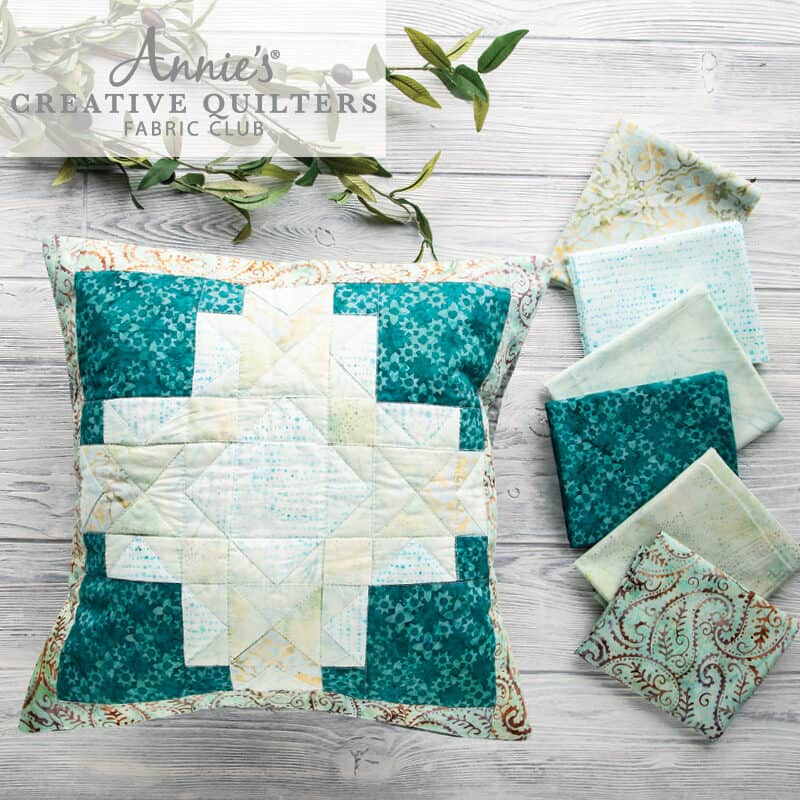
You’ll also find that seamstresses are incredibly partial to their particular machine whether it’s overlock, serger, or cover stitch. Read on to learn more about what you should choose when shopping serger vs overlock and find out which machine is right for your specialty sewing needs.
image via: pixabay

What Does a Serger Sewing Machine Do?
While they call it a sewing machine, the tasks a serger sewing machine will perform are those that no standard sewing machine can do. A serger sewing machine trims the seam on a piece of fabric and enfolds the edge of the fabric, often called the seam allowance, into a thread casing. This all happens in one simple step and often seems more like knitting than sewing.
As with any machine, there are different types of sergers that build on the serge stitch. The more expensive models of sergers will have more options available. Different machines will have different options for stitch width and density, and that is also something you should pay attention to when you are looking to purchase.
How Is a Serger Sewing Machine Designed?
A serger sewing machine is designed to perform serge stitching, cutting, and finishing perfectly and in one swift step. It has multiple spools of thread with the more expensive models have up to 8 different spools of thread. There are also at least three to four pathways that require threading on most serger sewing machines. The serger sewing machine will also have at least two loopers that perform the knitting required on the serge stitch and knives that cut the seam allowances as the machine serges them through the machine.
Why Would You Use a Serger Sewing Machine?
The main use for a serger sewing machine is in construction. When you are professionally finishing the inside portion of the garment. On rare occasions, one might use a serger sewing machine to finish a hem or embellish the seams on the outside of a garment as well. An example of this is in rolled hemming. But It is important to remember these instances are few and far between.
What Types of Stitches Does a Serger Sewing Machine Perform?
The most common of stitches on serger sewing machines are 2-thread, 3-thread, and 4-thread stitches. The 4-thread stitch is the most common and strongest of the stitches, the 3-thread stitch is used mostly for seams but isn’t as strong as the 4-thread so shouldn’t be used on garments or seams that receive a lot of stress.
2-thread stitches aren’t used on seams instead they are used as a finishing touch on a garment or to give the appearance fabric that has been cover stitched. Serger sewing machines also give you two options in terms of needles. You use the left needle for thicker thread or fabric, and the right needle for a finer thread type and lightweight fabric.
What Types of Decorative Stitches Does a Serger Sewing Machine Perform?
The serger sewing machine obviously performs the serge stitch, but most machines can also perform a flat-locking stitch, a chain stitch and several decorative stitches that are used for finishing edges. A flat-locking stitch is used, when there is no seam allowance and the edges of the fabric you are stitching have been butted up against one another. The chain stitch is when the seam Wis looped together in a chain-like pattern. Other decorative stitches you might use on a serger include pin tucks, which create folds, and blanket stitches, that are used on heavier fabrics.
Serger Sewing Machines
Serger sewing machines come in several different models and these models are often labeled by their thread use options. Each model will have different stitches and produce different results. Some common serger sewing machine models are the:
2-4 Thread Serger
The serger sewing machine does a true safety stitch and a two thread serge edge. This is where two threads are used on each operation but the machine can create each stitch separately.
3-4 Thread Serger
This serger sewing machine functions with three or four threads and gives the seam more stretch. The four thread seam is wider and sometimes called the “mock safety” because it has the strength of a safety stitch seam. The 3-4 Threader will also normally have the ability to do a rolled hem.
5-Thread Serger
This serger sewing machine is the most expensive of the options but it has everything you could want in terms of seam capacity. It also allows you to do production work.
Overlock Sewing Machines
The main alternative to the serger sewing machine is the overlock sewing machine. An overlock sewing machine will still have the simple serge stitch, but won’t have cutting like a serger and will have fewer spools of thread. Overlock sewing machines also often perform a cover stitch. A cover stitch is a type of overlock stitch that is not included on serger sewing machines.
Because of the popularity of the cover stitch, overlock sewing machines are often called cover stitch sewing machines and are seen as interchangeable. But there will be overlock sewing machines that don’t have the cover stitch and cover stitch sewing machines that don’t have the simple serge stitch. To help with simplification, we will assume that overlock sewing machines have cover stitching and refer to both cover stitching and overlock sewing machines as simply, “overstock sewing machines.”
What Does an Overlock Machine Do?
The overlock sewing machine is also used for finishing garments and is definitely a good option for fixing hems. They are mainly used to finish the outside of the garment by hemming it or to add decorative effects to the garment like attaching lace or other trims.
How Is an Overlock Sewing Machine Designed?
The overlock sewing machine is simpler in its design, but it’s still versatile in function. It often looks like a serger sewing machine, but the stitching and capacities are different. The overlock sewing machine will have up to 3 needles to make narrow or wide hem stitches. It also has one looper, but no knives because it doesn’t cut the fabric as it goes and has more functions than just finishing the garment.
Why Would You Use an Overlock Sewing Machine?
Overlock sewing machines take all the trickery and trouble out of making a hem which is great for the would-be seamstresses who find this task too difficult or too time-consuming on a standard sewing machine. Overlock sewing machines are often wanted because of the cover stitch, which is good for stretchy garments and is able to get all the raw edges into the hem in one pass. You can also use an overlock sewing machine to add attachments to a garment. They attach lace, and elastic quickly and efficiently so you can do attach without fuzz or concern that comes from a regular sewing machine.
What Types of Stitches Does a Overlock Sewing Machine Perform?
Overlock sewing machines take all the trickery and trouble out of making a hem which is great for the would-be seamstresses who find this task too difficult or too time-consuming on a standard sewing machine. Overlock sewing machines are often wanted because of the cover stitch, which is good for stretchy garments and is able to get all the raw edges into the hem in one pass. You can also use an overlock sewing machine to add attachments to a garment. They attach lace, and elastic quickly and efficiently so you can do attach without fuzz or concern that comes from a regular sewing machine.
Serger vs Overlock Sewing Machines: The Difference
What’s the difference between serger vs overlock sewing machines? The simple answer is that the main difference between a serger sewing machine and an overlock sewing machine is in the serge functionality and cover stitch capacity of each machine. An overlock sewing machine will not have the cutting and spool capacity that a serger machine has, but is able to still perform the serge stitch and the cover stitch.
Serger vs Overlock: Performance
Serger sewing machines and overlock sewing machines both have two needles, a long foot, and a needle plate. So you might think the way they perform is similar, but it’s not. An overlock sewing machine is a very to the point, ready to go machine. It can be threaded and lay waiting for use. A serger sewing machine is full of options, from spools to styles, this is the machine for the seamstress who wants options. You can efficiently perform multiple tasks at one time with that specialty sewing machine that you can’t with an overlock sewing machine.
Serger vs Overlock: Ease of Use
Serger sewing machines and overlock sewing machines both have two needles, a long foot, and a needle plate. So you might think the way they perform is similar, but it’s not. An overlock sewing machine is a very to the point, ready to go machine. It can be threaded and lay waiting for use. A serger sewing machine is full of options, from spools to styles, this is the machine for the seamstress who wants options. You can efficiently perform multiple tasks at one time with that specialty sewing machine that you can’t with an overlock sewing machine.
Serger vs Overlock: Fabric
When comparing serger sewing machines and overlock sewing machines for their usability, it is clear that overlock sewing machines are easier. You can start using an overlock machine right away and you can master the functions on the machine quickly. This is because their design is decidedly more simple. The serger sewing machine has more functions, spools of thread, and types of stitches. Mastering all of its functions takes more time.
Serger vs Overlock: Threading
The serger sewing machine and the overlock sewing machine do have the same number of needles to thread, but the threading is very different on each machine. A serger sewing machine has several pathways that need to be threaded, and you can use up to 8 different spools of thread on a garment depending on the model of serger sewing machine you purchase. An overlock sewing machine is easier to thread than a serger sewing machine but has fewer spools to use. The overlock sewing machine can also remain threaded and waiting. Which makes the transition from a regular sewing machine to the overlock sewing machine quicker.
Serger vs Overlock: Creating Edges
The stitch width, stitch eccentric, and the number of stitches is different depending on the machine you choose. A serger sewing machine will have more stitches per inch than an overlock sewing machine. The higher number of stitches will create a denser and higher quality hem. A serger sewing machine will also give stitches greater width and a greater eccentric so the stitches are stronger and feel more solid than the stitches on an overlock sewing machine. Better stitches equal better edges on your garments.
Serger Vs Overlock: The Feed
The feed on a sewing machine is the group on metal ridges that come out of the hold in the throat plate of a sewing machine. They gently grip the fabric and hold it steady as it passes through the sewing machine and helps create a high-quality stitch. The feed on both serger sewing machines and overlock sewing machines vary by brand. The best machine will have multiple feeds and feeds that can be raised and lowered.
What about Combo Machines?
There are combo machines that allow you to create cover stitches and have a serging capacity at the same time. But these machines are often hard to configure and moving between the serging functions to the cover stitching is really cumbersome. For one thing, you won’t have the free arm that you have on a regular serger sewing machine. The other factor that puts most sewing enthusiasts off of getting a combo machine is that the quality of both functions is inhibited because they are combined on one machine.
Conclusion
There are so many options when shopping for a specialty sewing machine it’s hard to choose. The right specialty sewing machine will be the one that gives you a better sewing experience, helps you create better edges, and gives you more decorative options.
When looking at the difference in serger vs overlock sewing machines, both have their merits. When shopping for a simple machine the overlock sewing machine is the winner. But the clear winner is the serger if you want better edges and options. While overlock sewing machines may be cheaper sometimes because they have fewer functions, the serger machines cutting and additional spools put it over the line and make it the better specialty sewing machine to purchase if you can only choose one.
However, most sewing enthusiasts will tell you the secret to producing the most professional, beautiful garments possible is, you need both! Dedicated sewers will want to have both in their arsenal for producing the best garments. It is also still important to research and find a reputable seller who can help you. Often sellers will even offer classes to help you understand your machine. Happy sewing!
Last update on 2021-01-20 at 14:25 / Affiliate links / Images from Amazon Product Advertising API
